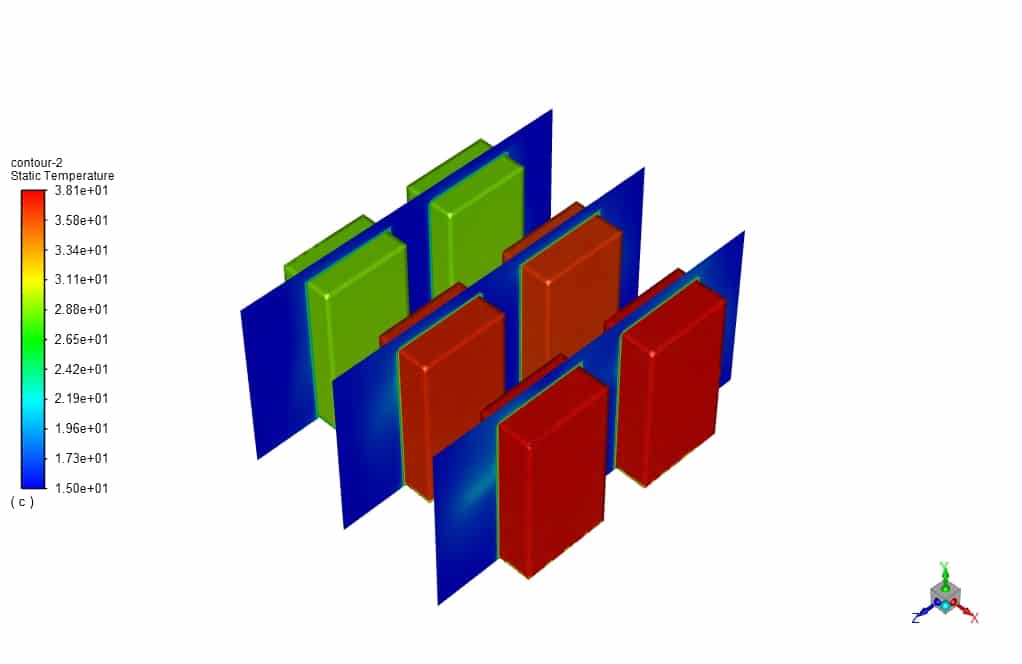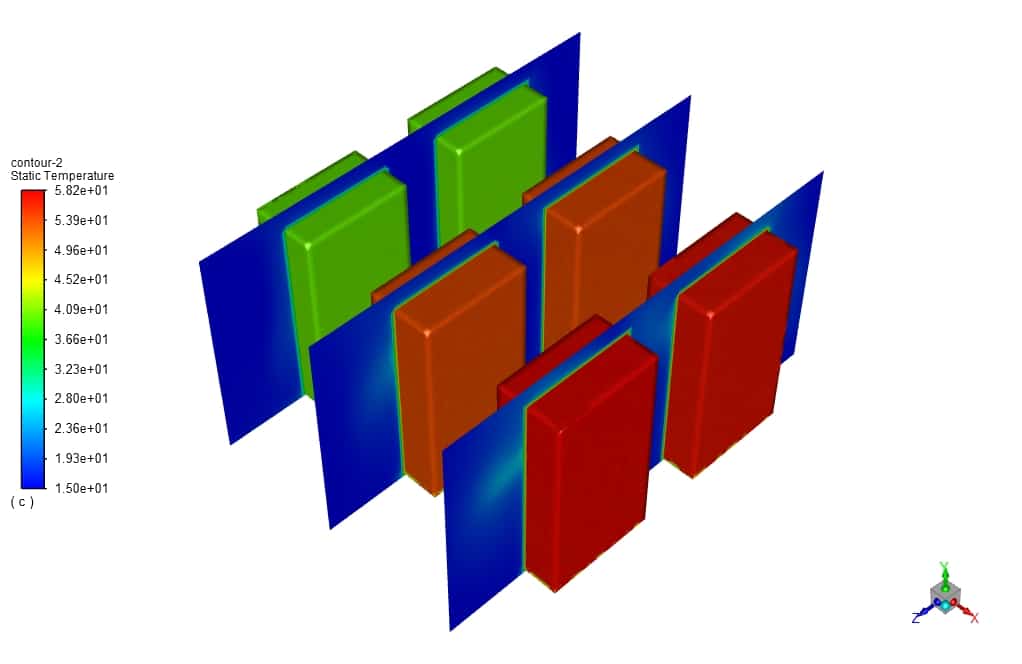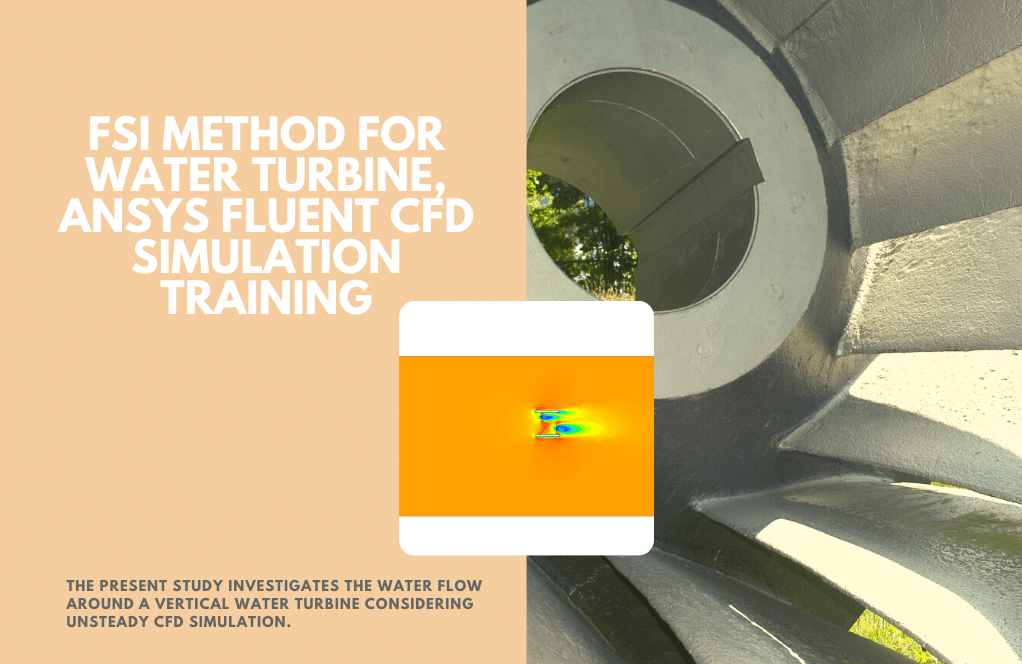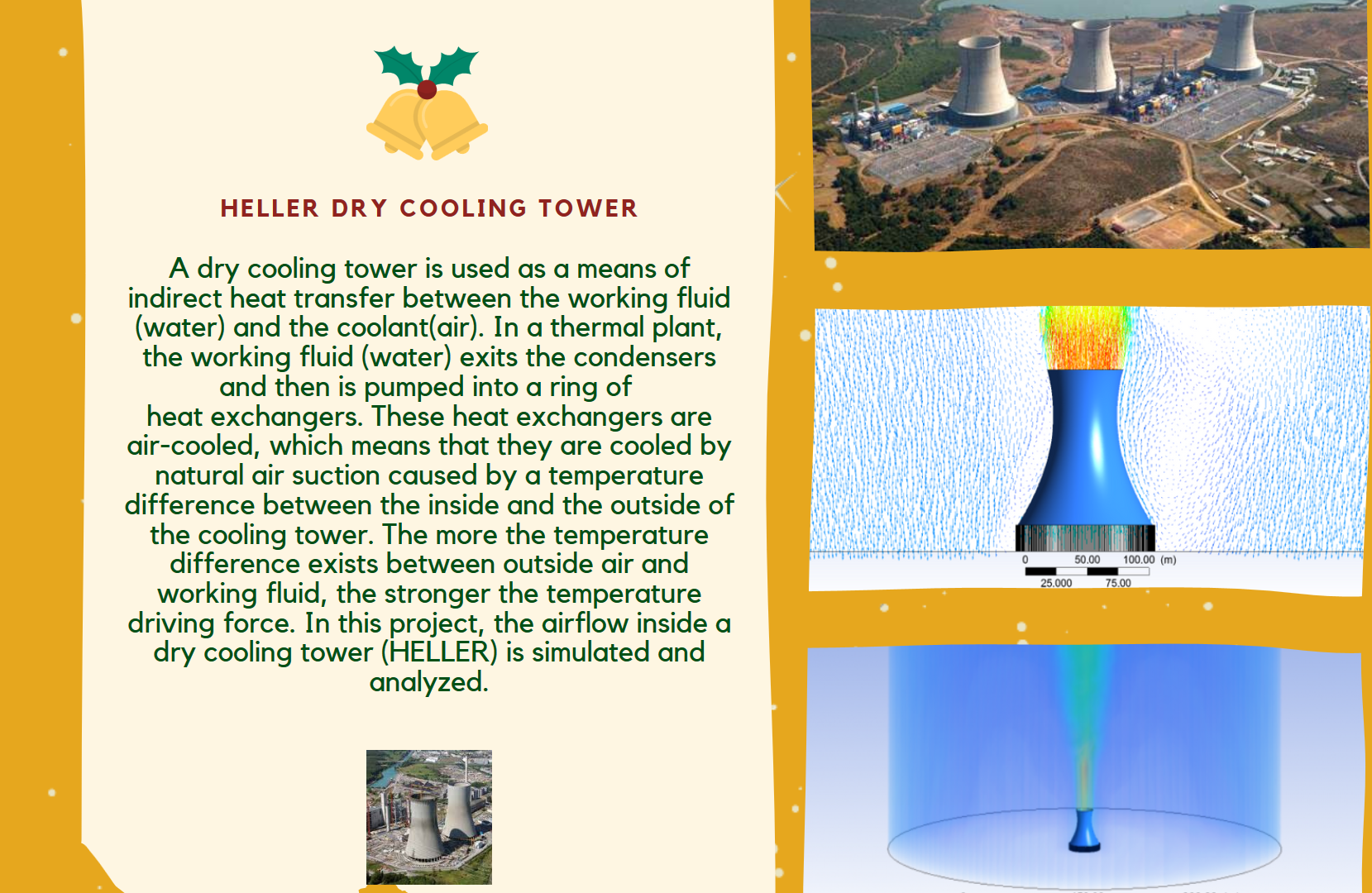Server Room Cooling CFD Simulation with 6 Cabinets
$100.00 Student Discount
- The problem numerically simulates Server Room Cooling with 6 Cabinets using ANSYS Fluent software.
- We design the 3-D model by the Design Modeler software.
- We Mesh the model by ANSYS Meshing software, and the element number equals 448000.
- The Energy Equation is activated, and a Heat Source is applied to the room.
Click on Add To Cart and obtain the Geometry file, Mesh file, and a Comprehensive ANSYS Fluent Training Video.
To Order Your Project or benefit from a CFD consultation, contact our experts via email ([email protected]), online support tab, or WhatsApp at +44 7443 197273.
There are some Free Products to check our service quality.
If you want the training video in another language instead of English, ask it via [email protected] after you buy the product.
Description
Server Room Cooling CFD Simulation with 6 Cabinet, ANSYS Fluent CFD Simulation Training
In this project, Server Room Cooling CFD Simulation with 6 cabinets, is carried out using ANSYS Fluent software. We perform this CFD project and investigate it by CFD analysis.
Essential parameters in a server room design include Precise Environmental Control, Airflow Planning, Fire Suppression systems, Cable Management Solutions, Redundant Power Sources, and Physical Security.
Meanwhile, the cooling of these rooms was considered with the help of computational fluid dynamics. The current model is designed in three dimensions using Design Modeler software. The dimensions of the room and cabinet are 7 * 4 * 2 meters and 1 * 0.6 * 1.8 meters, respectively.
The meshing of this project has been done with ANSYS Meshing software. The mesh type is structured, and the element number is 448000.
Server Room Methodology
To increase efficiency and reduce the risks of temperature rise in server rooms, the safe range offered by manufacturers is in the range of 10 to 32 degrees. Thus, decreasing the temperature below 10 degrees and increasing the temperature above 32 degrees creates unstable conditions in these rooms.
Therefore, the airflow inside the server room was modeled using Ansys Fluent. The air inlet temperature was 15 degrees, and the airspeed was 0.5 and 1 meters per second.
Also, the amount of heat generation in each cabinet rack was assumed to be 400 watts. Also, six cabinets were designed as heat sources inside the server room. In addition, in the figure below, the geometry of the problem was considered along with the boundary conditions.
This study aims to achieve stable thermal composition in the safe range regarding temperature for server rooms.
In this study, air-fluid was used as the working fluid, and due to the predominance of forced convection on the natural convection effect, the air density was assumed to be constant. Also, The table below shows the characteristics and values of boundary conditions, along with the models and hypotheses.
Server Room Conclusion
At the end of the solution process, two-dimensional and three-dimensional contours related to temperature and streamlines are obtained.
In this part, by observing the temperature contour in different sections and the diagram of the maximum and average temperature of the fluid, it was shown that the maximum temperature condition of fewer than 32 degrees was not satisfied.
Thus, by increasing the input speed, we eliminate this shortcoming. The graph of the maximum and average temperature of the fluid bulk for the inlet speed of 1 m / s during the solution is shown in the figure below.
As it is clear, the maximum temperature has reached the safe range of the server room as the speed increases. In the diagram below, it was clear that the maximum temperature has reached the range of 30 degrees, and increasing the speed has positively affected better cooling of the racks.
The following counters are the temperature for the two modes with speeds of 0.5 and 1 meter per second, respectively.
0.5m/s:
1m/s:









Cristobal Cole –
I enjoyed going through the CFD simulation materials of the server room cooling project. The detail on heat management and airflow planning is particularly impressive. Great job showing the impact of increased inlet speed on achieving the target temperature specifications!
MR CFD Support –
Thank you so much for your positive review of our Server Room Cooling CFD Simulation materials. We’re thrilled to hear that you found the materials informative and useful in understanding heat management and airflow planning for server rooms. Your appreciation means a lot to us and we’re happy that the dedication to showcasing detailed simulation impacts resonated with you. Thank you for your support!
Larry Tromp –
I recently completed the server room cooling CFD simulation with 6 cabinets. My experience with the step-by-step setup and execution of the simulation through ANSYS Fluent was seamless, and I’m impressed with the clear presentation of both the problem and methodology. The visual outputs were particularly helpful in understanding the flow dynamics and temperature changes within the server room. The temperature contours and streamline patterns clearly illustrated the effectiveness of the cooling strategy at different air inlet speeds. The inclusion of equipment like cabinet racks as heat sources added realism to the study. Well done on creating such an in-depth and learning-enriching simulation!
MR CFD Support –
Thank you for taking the time to provide feedback on the Server Room Cooling CFD Simulation with 6 Cabinets. We are thrilled to hear that you found the simulation comprehensive and that it effectively conveyed the complexity of server room cooling systems. It’s rewarding to know that our visuals helped in your understanding and that the presentation met your expectations. At MR CFD, we aim to deliver high-quality learning experiences and your positive review reaffirms our commitment to this goal. Thank you for choosing our product, and we look forward to assisting you in future learning endeavors!
Allene Denesik II –
The Server Room Cooling simulation was enlightening! The detailed boundary conditions and the airflow management strategies were quite innovative. It’s impressive to see how changes in airspeed can dramatically influence temperature regulation.
MR CFD Support –
Thank you for your positive feedback! We’re thrilled that you found the server room cooling simulation enlightening and were impressed by the detailed approach to achieving optimal thermal conditions. The effective management of airflow to regulate temperature within safe limits is crucial in server room design, and we are delighted that our simulation showcased this successfully.
Sasha Breitenberg V –
I’m impressed by how the simulation takes into various technical details for server room cooling. Can you explain (in the simplest way) why increasing the airspeed improved the cooling of the racks?
MR CFD Support –
Thank you for your kind words! To put it simply, when you increase the speed at which air moves over the heated cabinets (the racks), more heat is carried away from them at a faster rate. It’s like when you blow on hot soup to cool it down – the faster you blow, the quicker it cools. In this simulation, bumping up the airspeed helped to transfer more heat from the server racks, keeping the temperature within the safe operation range.
Miss Nicole Kozey –
What specific cooling techniques were prescribed for optimizing the airflow inside the server room in this CFD analysis?
MR CFD Support –
In the simulation analysis for the server room cooling, optimizing airflow is achieved by controlling the inlet temperature and velocity of the air. The given air inlet temperature was set to 15 degrees Celsius, and the airspeed to 0.5 and 1 meter per second, respectively. Additionally, the heat generation of each cabinet rack was assumed to be 400 watts which were also modeled as heat sources. These parameters were critical in maintaining a stable thermal environment within the safe temperature range for the server room. Increasing the input airspeed to 1 meter per second significantly improved cooling effectiveness, ensuring that maximum temperature stayed within the recommended limits of 32 degrees Celsius for server room operations.
Webster Brown –
The training helped me understand server room cooling much better! The detailed analysis and clear visuals provided a strong understanding of airflow and temperature management within such critical environments.
MR CFD Support –
Thank you for your positive feedback! We’re thrilled to hear that our Server Room Cooling CFD Simulation training was helpful and that the detailed analysis and visuals met your expectations. If you require further learning materials or have any other questions, don’t hesitate to contact us.
Lonnie Wiegand –
What methods were used to ensure stable temperature conditions within the safe range during the server room cooling simulation?
MR CFD Support –
In this simulation for server room cooling, several techniques were utilized to maintain a stable temperature within the safe range. The air inlet’s specified temperature was 15 degrees and the airflow velocities were 0.5 and 1 meter per second to regulate the temperature effectively. Each cabinet rack was also modeled to generate 400 watts of heat, and a structured mesh was implemented for precision. With adjustments to the input airflow speed, we were able to keep the maximum temperature within the recommended limit of 32 degrees, ensuring effective cooling for the server racks.
Gilda Dickinson –
The output of the server room CFD simulation is impressive. I noticed lower temperatures were achieved when the input speed was increased—well thought out approach ensuring all equipment stays within the safe operational range. Excellent visualization of the temperature distribution! Please consider implementing these insights into actual server room designs for optimal performance.
MR CFD Support –
Thank you for your positive feedback and appreciation of the CFD simulation’s results. It’s great to hear that our careful approach to optimizing airflow to maintain safe temperature ranges was helpful. We are glad that the visualizations effectively conveyed the temperature distribution and that these insights are valuable for practical server room operations. Your encouragement is greatly valued.
Ollie Rath –
I noticed the simulation regarded air density as a constant because forced convection predominates. Does it mean that buoyancy effects due to temperature changes were ignored, and if so, does it affect the accuracy of the simulation for environments with significant temperature gradients?
MR CFD Support –
In the described Server Room Cooling CFD Simulation, by considering air density as constant, the simulation indeed neglects the buoyancy effects or natural convection that occurs due to temperature gradients. This assumption is likely valid if the forced convection from the cooling systems is strong enough to overshadow the natural convection effects. However, in real server rooms with large temperature gradients and weaker airflow, omitting these effects might reduce the accuracy of the simulation. The specifics of the case should determine whether buoyancy effects are modeled.
Amaya Nolan –
The project description about the Server Room Cooling CFD Simulation is thorough and insightful. I particularly appreciate the detailed analysis on temperature management and the effective use of boundary condition settings to ensure that server equipment operates within safe thermal limits.
MR CFD Support –
Thank you for your kind words. We are glad that you found the project description informative. Ensuring that server rooms operate within the prescribed thermal limits is crucial, and we take pride in providing comprehensive CFD analyses to help achieve optimal cooling solutions. If you have any further queries or require assistance with similar projects, feel free to reach out to us!
Micheal Bergstrom –
I am very impressed with the CFD simulation of the server room. The approach you took to model the airflow and temperature effects at different speeds provided useful insights into maintaining optimal operating conditions for server reliability. Great job!
MR CFD Support –
Thank you for taking the time to review our product! We are thrilled to hear that our CFD simulation meets your expectations and provides the necessary insights for server room cooling. Your feedback is greatly appreciated and motivates us to keep providing high-quality simulations. If you require any further information or assistance, please do not hesitate to reach out.
Elmore Schmitt –
I used your Server Room Cooling CFD Simulation to plan my own server setup. I was impressed by how it helped me understand airflow and temperature management. Just phenomenal!
MR CFD Support –
Thank you for your positive feedback! We’re thrilled to hear that our Server Room Cooling CFD Simulation was helpful for your planning. It’s great to know the product could provide you with a clear understanding of the crucial aspects of airflow and temperature management in server rooms. If you need any further assistance or have any more computational needs, feel free to reach out to us.
Mr. Gerardo McKenzie –
I was impressed with the versatile use of ANSYS Fluent in simulating the cooling in server rooms. The results seem very useful for planning and enhancing the solutions for overheating issues. It’s great how detailed the analysis is while still adhering to the safety temperature range. Well done on achieving such clarity in representing temperature distribution and flow patterns in the outcomes.
MR CFD Support –
Thank you for your positive feedback! We’re glad to hear that the details and clarity of the simulation outcomes for the server room cooling have met your expectations and provided useful insights for practical applications. Our goal is to deliver comprehensive CFD analysis that aids in overcoming real-world challenges such as overheating in server rooms. We appreciate your comments and are pleased that our efforts have resonated with you.
Lloyd Wehner –
I’m thrilled with how the Server Room Cooling CFD Simulation with 6 Cabinets has been able to help design efficient cooling systems. By setting the inlet conditions and rack heat generation values outright, we can ensure our server rooms are always within the optimal temperature range. The visuals in temperature and streamline contours really helped to understand airflow dynamics. Great job on offering such a practical and robust simulation tool!
MR CFD Support –
Thank you for your positive feedback! We’re delighted to hear that our Server Room Cooling CFD Simulation has been beneficial in helping you understand and design efficient cooling systems for server rooms. It’s great to know the provided visuals were helpful for you. If you have any more insights or need further assistance, please do not hesitate to contact us. Your satisfaction with our products is our top priority!
Jarret Pfeffer –
Fantastic simulations of server room cooling! Being in IT, I’ve struggled with hot spots in our data centers before. Learning about airflow planning through these CFD models already has me thinking differently about our setup. Results clearly show how crucial proper air distribution is for maintaining safe temperatures.
MR CFD Support –
Thank you for your kind words! We’re thrilled to hear that our simulation is offering you new insights into airflow planning for your data centers. Effective cooling strategies are critical for server room optimization, and it’s wonderful to know that our product has been beneficial for you. We remain committed to providing high-quality learning tools to help our customers tackle real-world challenges like yours.
Seamus Schuster –
How did the team ensure even cooling throughout the room, especially when dealing with hotspots near the servers?
MR CFD Support –
The team designed the airflow strategically to pass through all racks, ensuring that colder air reaches potential hot spots. The airflow patterns and speeds were optimized, and precise placement of cabinets and cooling outputs assisted in even distribution of the cooled air to mitigate hotspots.
Gayle Hegmann –
The training was extremely helpful for understanding the cooling requirements of a server room. However, I’m curious whether there’s a significant difference in the cooling efficiency when the speed of incoming air is at 0.5 m/s compared to 1 m/s. Could you clarify this?
MR CFD Support –
Absolutely, there is a notable difference in the cooling efficiency. The simulation reveals that at 0.5 m/s, the cooling is less effective, leading to temperatures that potentially exceed the safe threshold of 32 degrees Celsius. Conversely, when the airflow speed is increased to 1 m/s, the increased air movement facilitates better heat dissipation, keeping temperatures within the desired safe range. This effectively underscores the impact of airspeed on maintaining optimal thermal conditions in server rooms.
Sister Feest –
I’m curious how you determined the exact heat generation value of 400 watts for each cabinet rack.
MR CFD Support –
The heat generation value of 400 watts per cabinet rack is typically determined based on the average power consumption of the servers or equipment stored within each rack. It takes into account a standard or average for the thermal output measured from such electronic components during operation. In real-world applications or setups, this value would come from the technical specifications provided by the equipment manufacturers or from measurements taken in the actual server environment.
Elaina Weimann –
What is the total power generated by the cabinets in the server room simulation and how does it affect the cooling strategy?
MR CFD Support –
In the Server Room Cooling CFD Simulation with 6 cabinets, each cabinet rack is assumed to generate 400 watts of heat. With 6 cabinets, the total power generated would be 2400 watts. This heat generation significantly influences the cooling strategy, as the air conditioning system must be capable of removing this amount of heat to maintain the safe temperature range for proper server operation (10 to 32 degrees Celsius). The cooling strategy involves setting appropriate air inlets with sufficient velocity and temperature to handle the heat load and ensure stable temperature conditions within the server room.
Reanna Casper –
The quality and details in the reporting of the server room cooling simulation are impeccable! The impressive clarity in explaining the methodology, including both boundary conditions and the consideration of different elements like temperature range and airspeed, is very informative. The way in which potential issues like temperature exceeding 32 degrees were addressed is particularly notable. Wonderful work!
MR CFD Support –
Thank you for your positive feedback! We’re so glad the detailed description of the Server Room Cooling CFD Simulation was helpful and informative. Our goal is to provide comprehensive and precise information to assist users in understanding all aspects of each project. If you have any more questions or need further assistance, please don’t hesitate to reach out. Your satisfaction with our learning products is our top priority!
Emil Thompson –
I am thrilled with the findings from the Server Room Cooling CFD Simulation! The detailed analysis has provided clear insights into air flow patterns and temperature distribution. Looks like adjusting the inlet air velocity had a significant positive impact on maintaining the temperature within safe limits. The 3D temperature contour graphics were also quite informative. Has this project been applied to real-world server rooms, and if so, what has been the feedback?
MR CFD Support –
Thank you for your compliments! Yes, the methodologies and findings from the CFD simulation are applicable to real-world server room designs and have been instrumental for many of our clients in optimizing their cooling systems. Feedback from these real-life applications has been very positive, with reports of enhanced cooling efficiency and better temperature control within the optimal range specified for electronic equipment. Users have appreciated the ease with which they can visualize potential hot spots and address them proactively, thanks to the simulation.
Jaquelin Huels –
What an informative and complete product description! I am truly impressed with how in-depth the CFD simulation of server room cooling with six cabinets is explained. The presentation of methodology and conclusion provided is clear, making it quite evident that a lot of work went into ensuring accurate and useful results. It’s obvious that this training would be highly beneficial for anyone involved in design and management of data center cooling systems. Great job!
MR CFD Support –
Thank you for your kind words and appreciation of our Server Room Cooling CFD Simulation project. We are delighted to hear that the project description met your expectations and offered a comprehensive learning experience. Our goal is to provide detailed and methodical training to help professionals manage their server rooms more efficiently, and we are glad to have achieved that. Your feedback is very motivating for our team!
Arvilla Bartell –
I’ve learned a lot from the Server Room Cooling CFD Simulation course, especially about the importance of maintaining the correct temperature ranges for optimal server function. Really enjoyed the practical approach to problem-solving!
MR CFD Support –
We’re so pleased to hear that the Server Room Cooling CFD Simulation course has been beneficial to you. Your positive feedback motivates us to continue delivering quality learning experiences. Thank you for taking the time to appreciate our product!
Larissa Haley –
Is it possible to visualize the distribution of temperature within the server room using the simulation data?
MR CFD Support –
Certainly! The simulation data allows for visual representation in the form of temperature contours. These contours show how hot air circulates where the coolest areas are located, and this can help in optimizing the layout for better thermal management.